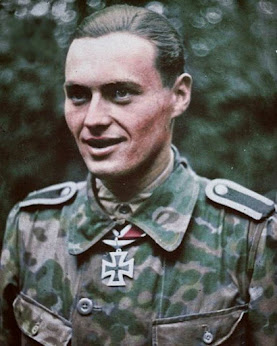 |
| Helmut Schreiber as SS-Hauptsturmführer |
 |
| Original SS-Regiment Deutschland Officer's Cuff Title |
Helmut Schreiber from Gießen volunteered for the
SS-VT at age 21. He was assigned to SS-Standarte Deutschland, where he underwent tough physical and military training and participated in the
Anschluss of Austria and the
occupation of the Sudetenland in 1938. Following his training at
SS-Junkerschule Bad Tölz and additional specialized training in Wien in Austria, he was assigned back to his former division, SS-Division Reich, as a platoon leader in SS-Infanterie-Regiment Deutschland. Schreiber distinguished himself in the fighting on the Eastern Front. The young officer learned all facets of the infantry war: Conducting assaults while covered by friendly mortar fire; fighting in trenches for enemy positions; combat patrols with attached flamethrower teams or snipers; house-to-house fighting in nameless villages; to name just a few aspects. Schreiber's company often experienced several days of intense fighting without a break. It demonstrated itself to be a tough unit.
The regiment experienced great success in the fighting to retake
Kharkov at the beginning of 1943. When SS-Obersturmführer Schreiber and his company of daredevils were victorious against a numerically superior Soviet combat formation, he personally received the German Cross in Gold from SS-Obersturmbannführer
Heinz Harmel's hand. Schreiber was promoted to SS-Hauptsturmführer on June 21 1943. On July 8 1943, during the
Battle of Kursk, the Soviets attacked the positions of SS-Hauptsturmführer Schreiber's battalion, supported by strong tank forces. In the sector of Regiment Deutschland, 83 enemy tanks were destroyed. Shortly after 16:00 hours the enemy broke through the open left flank. Schreiber immediately recognized the danger threatening the battalion. He mustered together a platoon of his company and conduted a textbook assault into the flank of the enemy. After a bitterly hard battle the enemy was thrown out of his positions. Taking advantage of the initial success, Schreiber began a further attack on his own initiative and advanced through no-man's-land. In a sweeping attack the enemy positions were overrun and captured. Schreiber's actions closed the enemy's essential escape route. For those actions, he was awarded the covered Knight's Cross on July 30 1943.
On April 1944, Schreiber was promoted to SS-Sturmbannführer and given command of III./SS-Panzergrenadier-Regiment Deutschland. After an urgently needed reconstitution in France, the experience and combat power of 2.SS-Panzer.Division Das Reich were brought to bear on the
Invasion Front in May 1944. But against the material superiority of the British and the Americans, even the battle-scarred Waffen-SS veterans were powerless. Despite it all, however, Schreiber had some success during the defensive fighting at Caen and Falaise. SS-Sturmbannführer Helmut Schreiber and the equally highly decorated SS-Brigadeführer
Sylvester Stadler surrendered to the Americans in Austria on May 4 1945. Before the proud SS veteran took this final difficult step, he had the presence of mind to save his awards from the greedy hands of the victors. The Knight's Cross and the Close Combat Clasp in Gold lasted through the months of captivity in the hollow wooden leg of an officer comrade. As a result, the deserving warrior had those awards until his last day of life. Schreiber was one of only 98 German soldiers that received both the Knight's Cross and the Close Combat Clasp in Gold. After the war, he was wanted by the French authorities for suspected involvement in the
Oradour massacre. Therefore, Schreiber lived under the false name
Helmut Kraus. In 1957, he was recruited by the West German Federal Intelligence Service (BDN) from which he retired in 1980. Schreiber died aged 91 on Dec. 6 2008 in München. Source: Florian Berger:
The Face of Courage. Images: Fair use
.






































